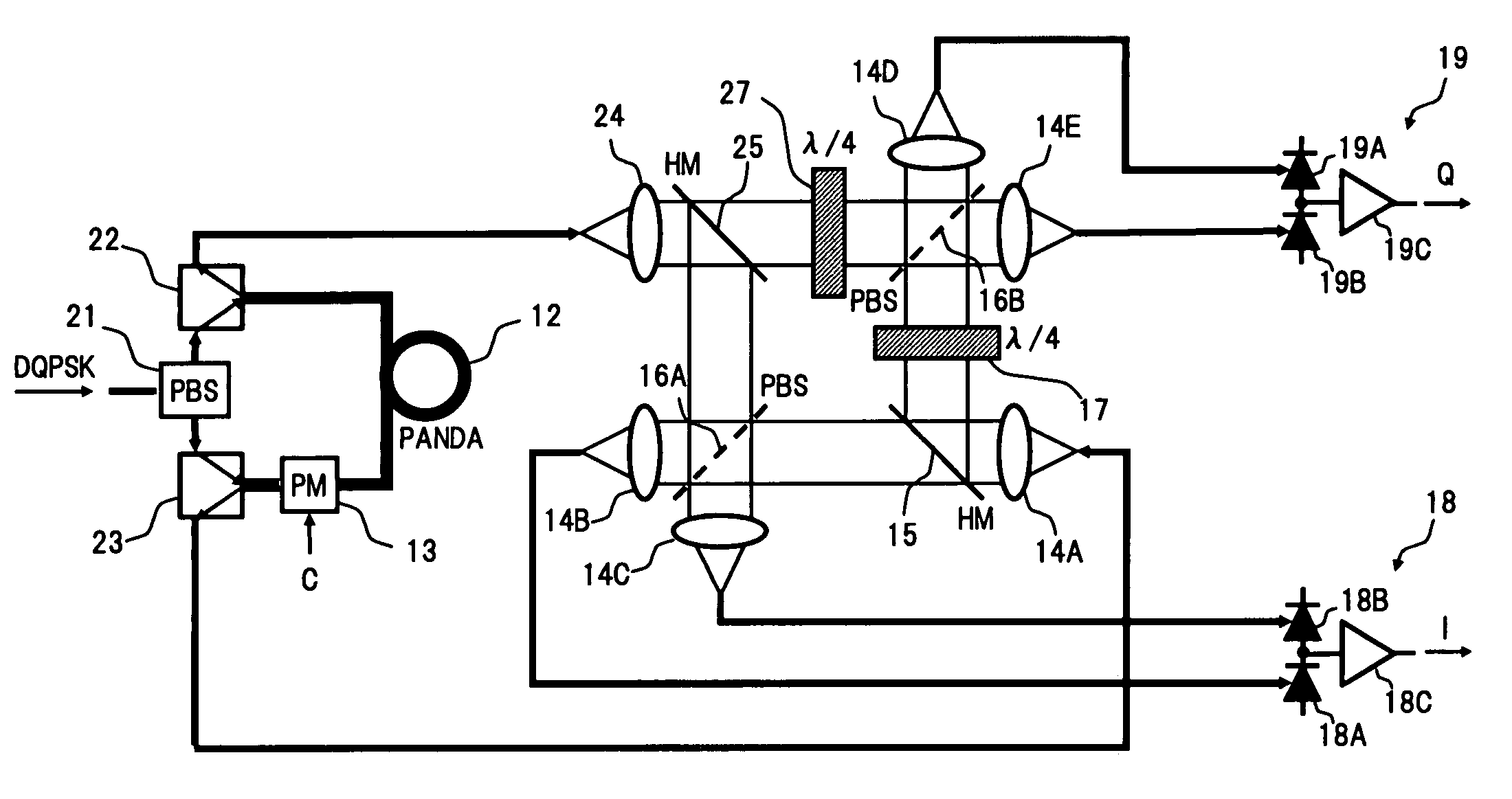Optical receiver and optical reception method compatible with differential quadrature phase shift keying
a technology applied in the field of optical receiver and optical reception method, can solve the problems of deviating from the required value of delay interferometer, large optical receiver scale, and large size of optical receiver, and achieve the effect of low cost and stably demodulating
- Summary
- Abstract
- Description
- Claims
- Application Information
AI Technical Summary
Benefits of technology
Problems solved by technology
Method used
Image
Examples
first embodiment
[0031]FIG. 1 is a block diagram showing a configuration of an optical receiver according to the present invention.
[0032]In FIG. 1, the optical receiver in the present embodiment comprises, for example, an automatic polarization controller (APC) 11 as a polarization converting section, a PANDA (Polarization-maintaining AND Absorption reducing) type fiber 12 as a birefringent optical medium, an optical phase modulator 13 as a delay time difference correcting section, collimator lenses 14A to 14E, a half mirror (HM) 15 as a branching section, polarization beam splitters (PBS) 16A and 16B as first and second polarization separating sections, a ¼ wave plate (π / 4) 17 as a birefringent amount difference generating section, and differential reception circuits 18 and 19 as first and second reception sections.
[0033]The automatic polarization controller 11 receives, at an input port thereof, a DQPSK signal light transmitted via an optical transmission path connected to the present optical rece...
second embodiment
[0044]Next, there will be described the present invention.
[0045]In the above first embodiment, there has been shown the configuration example in which the polarization state of the input light is controlled by the automatic polarization controller 11, so that the DQPSK signal light input to the optical receiver becomes the linearly polarized light inclined by 45° to the intrinsic axis of the PANDA type fiber 12. However, generally, the polarization state of the signal light which is propagated through the optical transmission path or the like to reach the optical receiver is arbitrarily changed at a high speed. Therefore, there is a problem in that the automatic polarization controller 11 needs to be operated at a high speed following the change in the polarization state. In the second embodiment, the description will be made on an application example of a so-called polarization diversity system, in which the DQPSK signal light in an arbitrary polarization state can be received with...
third embodiment
[0056]Next, there will be described the present invention.
[0057]FIG. 3 is a block diagram showing a configuration of an optical receiver according to the third embodiment.
[0058]In FIG. 3, the optical receiver in the present embodiment comprises, for example, an automatic polarization controller (APC) 31 as a polarization converting section, a planar lightwave circuit (PLC) 32 in which one delay interference section 35 and two polarization separating sections 36A and 36B, are formed on the same substrate, and differential reception circuits 33 and 34 as first and second reception sections.
[0059]The automatic polarization controller 31 is capable of arbitrarily changing the polarization state of the DQPSK signal light input to the present optical receiver, similarly to the automatic polarization controller 11 in the first embodiment. Here, this automatic polarization controller 31 monitors therein the polarization state of the DQPSK signal light input to an input port thereof to autom...
PUM
| Property | Measurement | Unit |
|---|---|---|
| optical path length | aaaaa | aaaaa |
| differential currents | aaaaa | aaaaa |
| differential currents | aaaaa | aaaaa |
Abstract
Description
Claims
Application Information
 Login to View More
Login to View More - R&D
- Intellectual Property
- Life Sciences
- Materials
- Tech Scout
- Unparalleled Data Quality
- Higher Quality Content
- 60% Fewer Hallucinations
Browse by: Latest US Patents, China's latest patents, Technical Efficacy Thesaurus, Application Domain, Technology Topic, Popular Technical Reports.
© 2025 PatSnap. All rights reserved.Legal|Privacy policy|Modern Slavery Act Transparency Statement|Sitemap|About US| Contact US: help@patsnap.com



